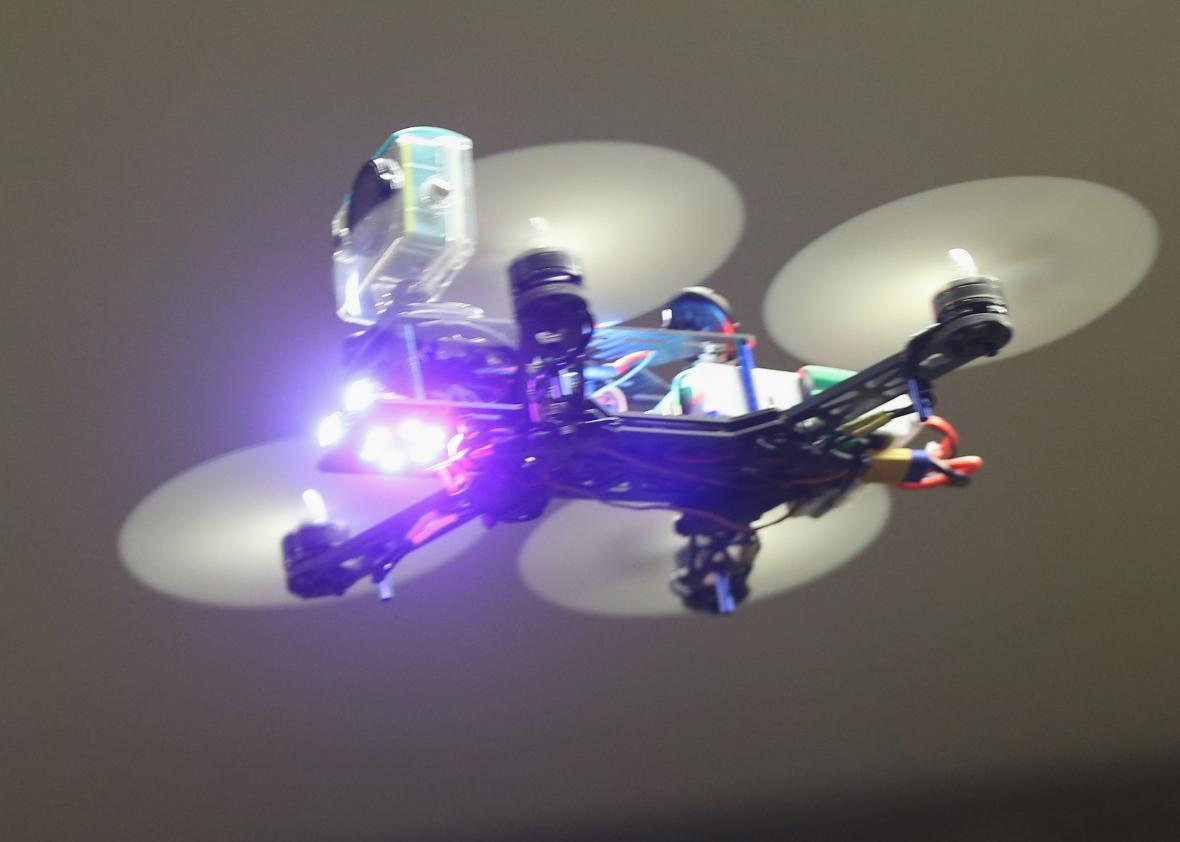Drone Racing Is Fun. But This British Kids’ Show Demonstrates How Dull It Is to Watch.

Sean Gallup/Getty Images
Last week I wrote about a forthcoming children’s toy called Barbie Star Light Adventure RC, otherwise known as “Drone Barbie.” The toy—which I saw as Mattel’s somewhat cynical attempt to exploit the drone craze—implies that the best way to get children interested in drones is to sell them a cheap one with a Barbie doll on top, like the synthetic cherry on a mechanical sundae. Now, a new children’s television show from Britain proposes an entirely different way to get kids interested in drones: Let them watch other children fly them through an obstacle course.
The Verge reports that the CBBC in Great Britain—CBBC=Children’s BBC, duh—has launched a show called Airmageddon, which features drones and destruction and small children in colorful uniforms, just like the Book of Revelation foretold. Airmageddon is an aerial version of BattleBots, basically, in which children compete to send their drones through various tricks and obstacles inside a futuristic arena. (Or, in the parlance of the show, “a purpose-built Air-rena.”) The show features lasers, pillars of fire, furious winds, an obstacle called the “Hurdles of Horror” (they’re just plain hurdles), a house drone built to resemble a flying pig, constant references to a robotic referee called the “Air Marshall,” an overenthusiastic announcer, and a host who has absolutely zero rapport with the youthful contestants. (“The children absolutely, visibly loathe him,” writes Joel Golby in the Guardian.) Each episode ends with a climactic final showdown in which two drones shoot lasers at each other until one of them goes down. The winning child advances to an eventual semi-finals; the loser, presumably, has to give back his costume.
I was not entertained by Airmageddon. The drones go really slow, and—at least in the episode I watched—there aren’t nearly enough crashes. The youthful drone pilots weren’t very good, and the obstacles were not very exciting. The Guardian’s Golby characterized Airmageddon’s version of suspense as “picking up magnets and putting them down inside a loop of LED lighting arranged artlessly on a concrete floor.” That said, the show is for kids. I’m trying to put myself into a kid’s shoes right now—it’s hard, my feet are too big—and if I were 12 years old in 2016, I would probably think that Airmageddon was sort of cool. Even as an adult, I would love to be a contestant on Airmageddon. Spend an afternoon flying drones around in a souped-up warehouse? Sign me up!
But there’s a difference between wanting to do something and wanting to watch other people do that thing. The CBBC is betting on the appeal of dronecraft as a spectator sport. (It’s probably also looking at the past success of other robot-themed competition shows, like the aforementioned BattleBots in the United States, the similar British program Robot Wars, and the Robot Wars spinoff Techno Games, which I have not seen, but which I can only assume involves sack races and Aphex Twin.) The network isn’t alone in this. There are a lot of entrepreneurs and enthusiasts who believe that there is a sizeable market for competitive dronesmanship. People love auto racing, and people love e-sports, and drone challenges theoretically combine elements of both pastimes into one irresistible package. In January, ABC News reported that the founder of the brand-new Drone Racing League “hopes people will watch for the racing excitement but also get to know the pilots, the same way people may have a favorite NASCAR driver.”
Alas, reviews of drone racing as a spectator sport have been mixed thus far. “[I]t's really hard to tell where the drones are in space, who's in which position, and how they are passing one another,” Ben Popper recently wrote of drone racing in the Verge. “A true sport requires more than a manufactured feeling of excitement from bombastic music, fast cuts between drones and pilots, and a staged slow motion crash at the end.” This same manufactured feeling of excitement prevails in Airmageddon, too. In October 2015, Faine Greenwood wrote for Slate about the appeal of the new sport of drone racing. “I’m a superhero when I fly,” the founder of the Aerial Sports League told Greenwood. “It’s out of this world.” Airmageddon is certainly out of this world, but, look, there are a lot of really boring parts of our solar system.
This article is part of a Future Tense series on the future of drones and is part of a larger project, supported by a grant from Omidyar Network and Humanity United, that includes a drone primer from New America.
Future Tense is a partnership of Slate, New America, and Arizona State University.

